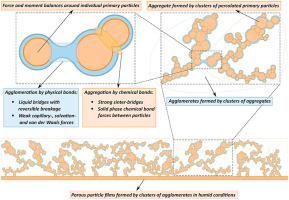当前位置:
X-MOL 学术
›
J. Aerosol Sci.
›
论文详情
Our official English website, www.x-mol.net, welcomes your
feedback! (Note: you will need to create a separate account there.)
A review of contact force models between nanoparticles in agglomerates, aggregates, and films
Journal of Aerosol Science ( IF 3.9 ) Pub Date : 2021-03-01 , DOI: 10.1016/j.jaerosci.2020.105719 Stefan Christian Endres , Lucio Colombi Ciacchi , Lutz Mädler
Journal of Aerosol Science ( IF 3.9 ) Pub Date : 2021-03-01 , DOI: 10.1016/j.jaerosci.2020.105719 Stefan Christian Endres , Lucio Colombi Ciacchi , Lutz Mädler

|
Abstract A desire to optimise the production and performance of nanoparticle structured materials has driven the development of increasingly accurate and fundamental models that describe their underlying physical and chemical mechanisms of interaction. In processes where particles form by nucleation and growth, such as aerosol synthesis processes, the primary nanoparticles can form complex assemblies referred to as aggregates, agglomerates and particle films. These materials typically consist of a distribution of primary particles in the nanoscale range (5–50 nm) which form chemically bonded aggregates (typical size range 200–300 nm) during their production. Aggregates in turn form larger structures called agglomerates which are held together by weaker forces arising from electrostatics, van der Waals, solvation or capillary effects. Extended particle assemblies with thicknesses in the order of 1–50 μm over substrate areas of the order of several square centimetre are referred to as particle films. These systems present a particularly challenging modelling problem due to their multiscale nature. Many classical models hold on the mesoscale and macroscale, while on the primary particle level many continuum laws break down and new contact models are required. In these particle-particle contact models, ambient conditions such as humidity have a large effect on the long-range capillary and solvation forces and thus on the final structure of the materials. This publication reviews the work that has been conducted in deducing the discrete physical laws that govern particle-particle contacts as well as their use in practical industrial processes and applications.
中文翻译:

团聚体、聚集体和薄膜中纳米颗粒之间的接触力模型综述
摘要 优化纳米颗粒结构材料的生产和性能的愿望推动了越来越准确和基本模型的发展,这些模型描述了其潜在的物理和化学相互作用机制。在通过成核和生长形成粒子的过程中,例如气溶胶合成过程,初级纳米粒子可以形成称为聚集体、附聚物和粒子膜的复杂组件。这些材料通常由分布在纳米级范围 (5–50 nm) 的初级粒子组成,这些粒子在生产过程中形成化学键合的聚集体(通常的尺寸范围为 200–300 nm)。聚集体反过来形成称为团聚体的较大结构,这些结构体通过由静电、范德华力、溶剂化或毛细管效应产生的较弱力保持在一起。在几平方厘米数量级的基板区域上具有 1-50 μm 数量级厚度的扩展粒子组件被称为粒子膜。由于它们的多尺度性质,这些系统呈现出特别具有挑战性的建模问题。许多经典模型适用于中尺度和宏观尺度,而在初级粒子水平上,许多连续定律失效,需要新的接触模型。在这些粒子-粒子接触模型中,湿度等环境条件对长程毛细管力和溶剂化力有很大影响,从而对材料的最终结构产生很大影响。本出版物回顾了在推导控制粒子-粒子接触的离散物理定律及其在实际工业过程和应用中的应用方面所做的工作。
更新日期:2021-03-01
中文翻译:

团聚体、聚集体和薄膜中纳米颗粒之间的接触力模型综述
摘要 优化纳米颗粒结构材料的生产和性能的愿望推动了越来越准确和基本模型的发展,这些模型描述了其潜在的物理和化学相互作用机制。在通过成核和生长形成粒子的过程中,例如气溶胶合成过程,初级纳米粒子可以形成称为聚集体、附聚物和粒子膜的复杂组件。这些材料通常由分布在纳米级范围 (5–50 nm) 的初级粒子组成,这些粒子在生产过程中形成化学键合的聚集体(通常的尺寸范围为 200–300 nm)。聚集体反过来形成称为团聚体的较大结构,这些结构体通过由静电、范德华力、溶剂化或毛细管效应产生的较弱力保持在一起。在几平方厘米数量级的基板区域上具有 1-50 μm 数量级厚度的扩展粒子组件被称为粒子膜。由于它们的多尺度性质,这些系统呈现出特别具有挑战性的建模问题。许多经典模型适用于中尺度和宏观尺度,而在初级粒子水平上,许多连续定律失效,需要新的接触模型。在这些粒子-粒子接触模型中,湿度等环境条件对长程毛细管力和溶剂化力有很大影响,从而对材料的最终结构产生很大影响。本出版物回顾了在推导控制粒子-粒子接触的离散物理定律及其在实际工业过程和应用中的应用方面所做的工作。











































 京公网安备 11010802027423号
京公网安备 11010802027423号